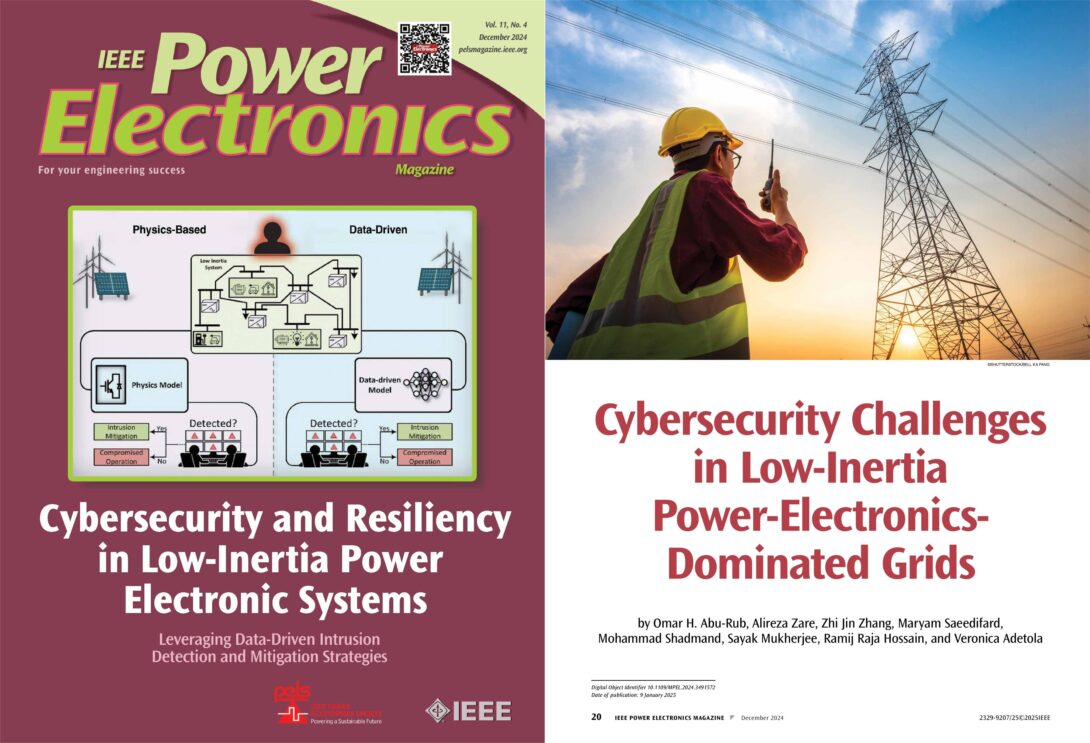Shadmand develops roadmap to protect electrical grids from cyberattacks
Roadmap to protect electrical grids from cyberattacks

Associate Professor Mohammad B. Shadmand and doctoral candidate Alireza Zare, along with collaborators at Georgia Institute of Technology, the University of British Columbia, and the Pacific Northwest National Laboratory (PNNL), had their paper Cybersecurity Challenges in Low-Inertia Power Electronics- Dominated Grids, featured on the cover of the December 2024 issue of IEEE Power Electronics Magazine.
Shadmand and his colleagues created a roadmap to make electrical grids more resilient against cyberattacks, proposing future research to address several critical gaps they identified.
The synchronous generators in a traditional power grid possess a physical property, inertia, which is critical to the grid’s stability. Inertia is the tendency of generators to resist changes in rotational speed, which provides stability during fluctuations in power demand or supply. Typically, the larger the generator, the greater the inertia.
Renewable power sources such as wind and solar are intermittent and require power electronics such as power inverters to connect to the grid. But the inverters are inertia-less, and replacing or augmenting synchronous generators with these inverters decreases the overall stability of the grid system. Maintaining system frequency stability is critical for reliable power system operation.
These power-electronics-dominated smart grids depend on communication networks to successfully integrate and control these inverters, which introduces cybersecurity vulnerabilities.
“Malicious actors could exploit these vulnerabilities for financial or political gain, potentially destabilizing grid operations,” Shadmand said. “Common methods are through malware, phishing attacks, and insider threats.”
These cyber events could include false data injection, denial of service, man-in-the-middle attacks, stealthy attacks, and advanced persistent threats targeted at power-electronics-dominated grids to disrupt the stability of the grid. To counteract such threats, these grid systems must be equipped with an ultra-fast real-time anomaly detection system and trajectory prediction mechanism to achieve effective cyber resiliency.
Cyber physical attacks—attacks which target both digital and physical systems–have skyrocketed, increasing 2000% percent between 2006 and 2019. One attack on a Utah-based renewable energy provider in 2019 resulted in multiple communication losses between their control center and solar and wind generating facilities. Similar attacks have targeted energy companies in Europe.
Shadmand said achieving cyber resilience in these systems requires accurate intrusion detection and robust intrusion mitigation. Challenges include accurately distinguishing between intrusions and benign system disturbances such as load changes, environmental variability, or inter-system interactions, and responding to these threats in real-time.
Finding a solution that overcomes the drawbacks of data-driven and physics-based approaches to these risks may involve physics-based machine learning. The researchers included five critical areas that merit further study to address these problems.
In addition to Shadmand’s student Zare, fellow researchers include Omar H. Abu-Rub and Maryam Saeedifard from Georgia Institute of Technology; Sayak Mukherjee, Ramij Raja Hossain, and Veronica Adetola from Pacific Northwest National Laboratory; and Zhi Jin Zhang at the University of British Columbia.